Belle Mina residents fear proposed quarry will cause irreversible damage
by Sydney Cromwell
Limestone Creek isn’t large, but it holds an outsize place in the tiny community of Belle Mina.
It’s not uncommon to see a truck pulled to the side of the road near Limestone Creek, so the driver can talk to a neighbor or friend fishing on the bank. In the summers, Belle Mina Methodist Church holds baptisms there.
“It’s a very culturally impactful spot for us,” said Rev. Cody Gilliam, the church’s pastor.
Sandhill and whooping cranes have been spotted hunting a meal at Limestone Creek, Gilliam said. Beneath the water, three species of endangered snails live out their lives in the rocky creek bed.
But the limestone that gives the creek its name has also attracted the interest of a quarrying company. Their proposal to build a quarry next door to Belle Mina could permanently alter Limestone Creek — and potentially send a new deluge of water and other problems directly at the families living there, opponents say.
‘NOT A LOT OF PLACES LIKE IT’
Meagan Alexander has been part of the Belle Mina community since she was a child. Her grandparents have lived there since the 1970s and raised a family in Belle Mina, and an aunt and uncle still live there.
While she’s now an adult living in Athens, Alexander said she’s still in Belle Mina on a weekly basis, visiting her grandmother and attending church.
“Belle Mina is just a very close-knit area. Everyone pretty much knows everyone on a first-name basis. It’s a very spiritual place, I would say, because a lot of people attend church there. And it’s a great place to build your family,” Alexander said.
Located southwest of Madison in Limestone County, Belle Mina has around 115 residents and sits next to the former plantation land of Bibb Manor, owned by Alabama’s second governor. Gilliam said the town is still home to descendants of both the slaves and slave owners from that plantation.
“There’s not really a lot of places in Alabama like it,” he said.
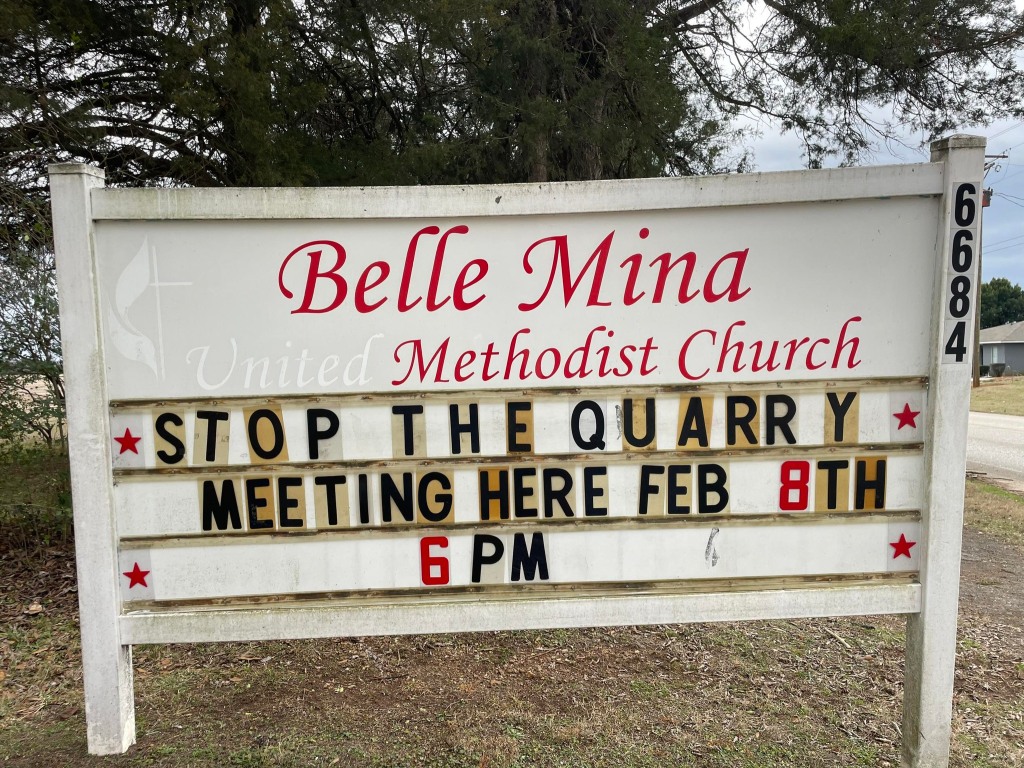
Gilliam is a newer face in the Belle Mina community, as he’s been pastor of the Methodist church for about two years and hopes to eventually fix the church parsonage so his family can move in.
In those two years, however, Gilliam said he has already watched one community spot be lost to industry. A bench in front of Belle Mina’s railroad station was the site where neighbors gathered and talked for many years, he said, until the Mazda Toyota manufacturing plant and Amazon fulfillment center opened nearby in 2022, and noise from the increased trucking traffic made those neighborly chats impossible.
“One thing that we all felt is the fact that our ability to gather as a community has been diminished by a number of things,” Gilliam said.
He doesn’t want to see another of these community spots lost through the development of a quarry.
‘EXISTENTIAL THREAT’
Most of Belle Mina’s opposition to the proposed limestone quarry is based on its chosen location. The quarry would be a very close neighbor — less than a hundred feet away from some Belle Mina homes and buildings.
Southern Environmental Law Center attorney Chris Bertrand described the mining operation as “literally just across the road” from families and churches. The SELC is helping the Belle Mina community in its opposition to the project.
“There’s just so many problems with this one quarry,” he said.
Limestone County doesn’t have zoning, which Bertrand said means there’s no protections to keep heavy industry away from homes.
“The fact that there’s no zoning means that people and their homes and their community are right up next to this site,” he said.

According to paperwork from the Alabama Department of Environmental Management (ADEM), the Athens-based company Grayson Carter & Son Contracting applied for an air quality permit and the Huntsville-based company Stoned, LLC, applied for a water quality permit for the quarry site late last year.
Southern Science reached out to representatives of both companies to learn more about the plans for the Belle Mina quarry, but neither returned calls or emails.
According to the air permit application, the 199-acre quarry site on Mooresville Road would mine, crush and screen an estimated 2.4 million tons of limestone on-site each year.
Alexander first heard about the proposal from her aunt and uncle, who live about half a mile away from the site. Gilliam said he learned about it right before the Iron Bowl last November.
“I just spent the whole game in despair,” he said.
Gilliam soon set up a community meeting at his church and found himself in the informal role of organizer and spokesman for the town’s opposition to the quarry.
Gilliam said he has invited Halston Carter, the president of Grayson Carter & Son, to lunch to talk about their concerns, but he was turned down. Bertrand said he hasn’t received any response from the two companies, either.
Hundreds of people from Belle Mina and neighboring communities like Mooresville and Greenbriar have been involved in meetings and filing comments with ADEM to explain their concerns. During a March 7 public hearing, Gilliam said more than 200 people showed up, all opposed to the quarry.
“I think everybody recognizes the existential threat this places upon their livelihoods, their homes and their churches,” Gilliam said.
COMMUNITY FEARS
Living next to a quarry means dealing with the possibility of dust, noise, heavy truck traffic and shaking any time the quarry is active. And, according to its permits, the Belle Mina quarry would be active 11 hours a day, five-and-a-half days a week, 50 weeks out of the year.
The quarry would use water to suppress dust from the crushing process; however, the permit states that an expected 20.26 tons per year of emissions (such as dust) would escape the site.
For neighbors who already have lung problems or other vulnerabilities, those particles could cause extra harm. This is one of Alexander’s primary fears — her grandmother has heart and lung issues, her uncle has a lung-scarring condition called sarcoidosis and her four-year-old cousin has asthma. All of them live in Belle Mina.
“They’re going to never escape poor air,” Gilliam said of residents with health conditions.
At the ADEM public hearing in March, the community brought Dr. Janice Thornton-Manning, a pulmonary toxicologist, to talk about the research that links inhaled dust and silica particles to a number of heart and lung conditions, cancer, birth defects and lower life expectancy.
“Based on the data provided this evening, it can be reasonably concluded that a quarry in the proposed location will have a catastrophic effect on the health and well-being of this historic community,” Thornton-Manning said at the hearing.
Pam Hunt, who regulates permitting for quarries in ADEM’s air quality department, said during the public hearing that the department’s preliminary determination was that the quarry “would not result in violations of applicable air quality standards designed to protect human health and the environment.”
“Too often, things like this go in next to African-American communities, and this is one of those times when we would like to say, ‘No,’ and have this stop here.”
Rev. Cody Gilliam, Belle Mina Methodist Church
Sinkholes are another potential side effect of the quarry’s activity, Gilliam said, because of the cracks and holes present in underground limestone. Blasting at the site could also cause shaking in nearby buildings on a regular basis.
“It’s going to look routine comparatively to all the other problems this thing is going to cause,” Gilliam said.
That shaking could ruin home foundations, Bertrand said, or damage a natural gas pipeline that runs through the proposed quarry site, less than a thousand feet away from the proposed mining area.
“It’s a real possibility this could destroy your home,” he said.
Alexander said she fears the blasting will cause damage to historic landmarks in the area, such as Belle Mina Methodist Church (built in the late 1890s) or Bibb Manor (built in the 1820s).
A medical device company called Curiteva, which has a manufacturing facility about a mile away in Tanner, wrote to ADEM that they were concerned the vibrations from blasting could damage their equipment.
Blasting also opens the possibility of damaging underground water reservoirs, threatening the water supply for families who use well water and for Limestone Creek, according to Paul Johnson, the supervisor of the Alabama Aquatic Biodiversity Center.
“That has the potential of fracturing the aquifer, and then all the groundwater continually drains inside the [mining] pit and they have to pump it out again,” he said. “… We don’t know how that may affect that system.”
Auburn University’s Alabama Agricultural Experiment Station, which has a research station in Belle Mina, also wrote to ADEM with concerns that the quarry operation would harm the water supply it uses for irrigation, livestock and research, and that potential sinkholes could be a danger to the station.
“I think everybody recognizes the existential threat this places upon their livelihoods, their homes and their churches.”
Rev. Cody Gilliam, Belle Mina Methodist Church
Randy Thomason, the CFO of Grayson Carter & Son, said during ADEM’s public hearing that the company had investigated the community concerns that arose after their permits were filed.
“We are confident these concerns do not apply to our site. We believe this quarry is needed in Limestone County to support economic growth and to maintain our infrastructure,” Thomason said. “… We are confident that we have fully met all of ADEM’s requirements for our permits. I am also confident that we will operate the Belle Mina quarry in a manner that will have minimal impact on the community.”
In a March letter to ADEM, C.W. McGehee of McGehee Engineering Corp., which has been working with Stoned, LLC, on some of the environmental concerns at the site, said that the quarry would preserve larger natural buffers than the state requires between its blasting and mining operations and nearby creeks. He said misunderstanding of the project has led to “unnecessary and unsubstantiated fears and concerns” about blasting, sinkholes and water impacts.
OVERFLOW
According to Bertrand, the water flow on the quarry site is a cornucopia of problems all on its own.
First, there’s how much water will be leaving the property. Then, there’s what the water will be carrying along with it.
“The idea that this quarry won’t have an adverse effect on the community is laughable if you just look at the flood plan. This quarry will be the demise of the Belle Mina community,” Gilliam said.
The property is already known to flood regularly, Bertrand said, even with only a couple inches of rainfall.
Quarrying won’t reduce that flooding issue, especially during strong storms, and all that water is going to have to be directed somewhere off the property.
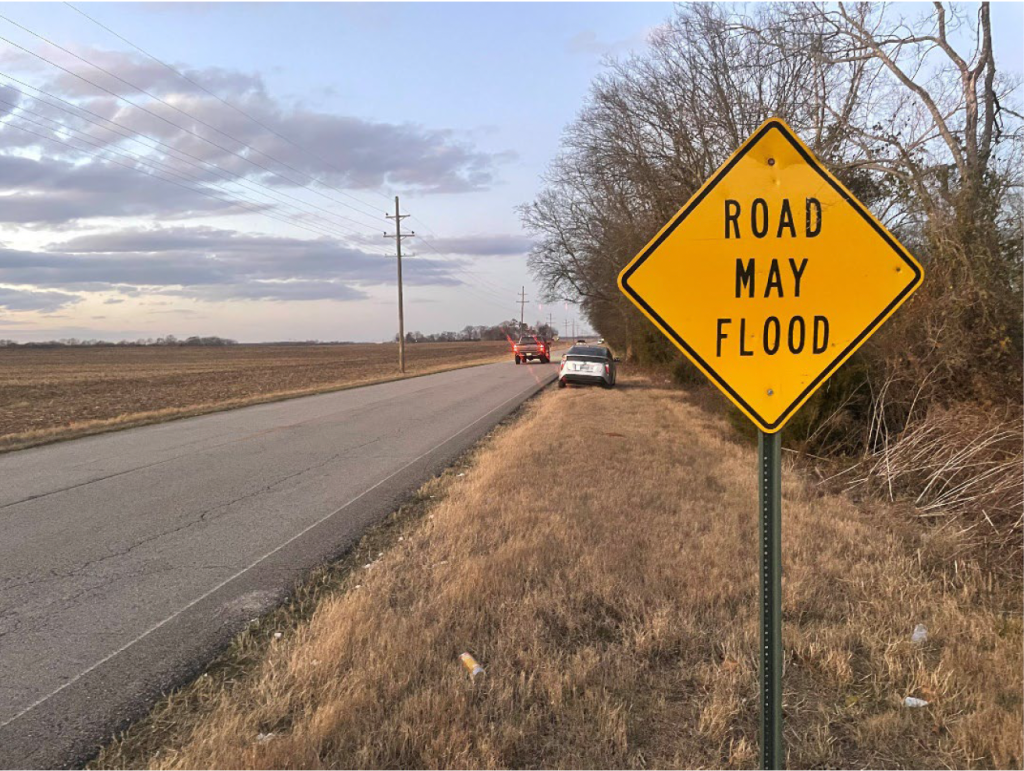
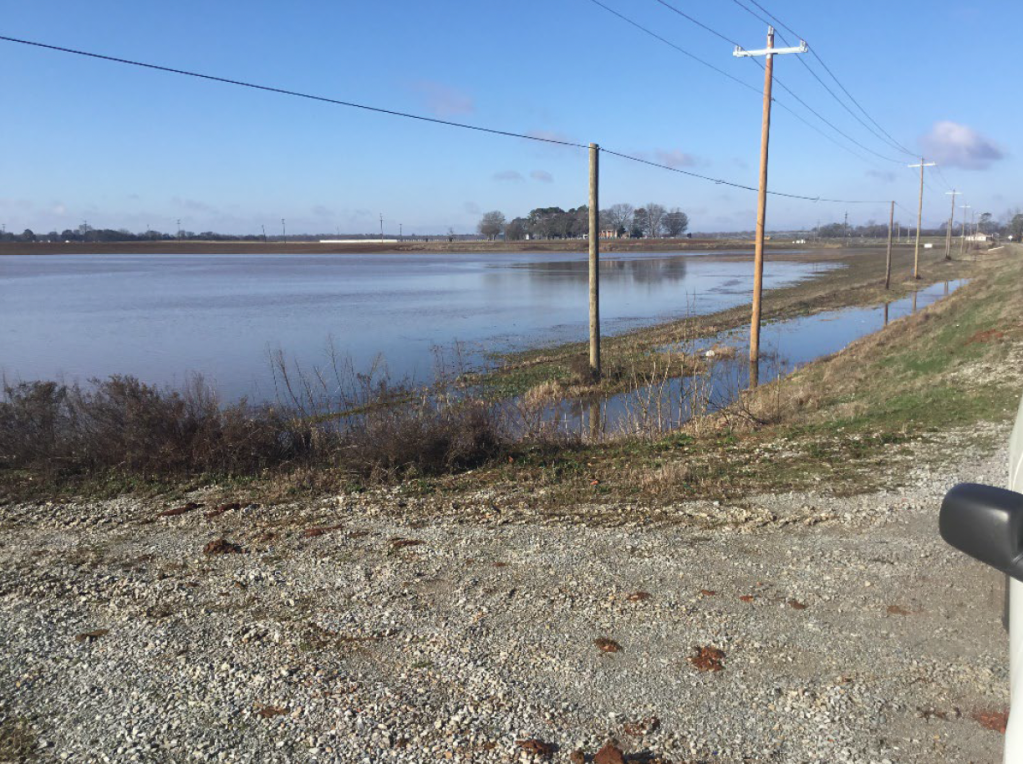
Bertrand said the permit applications for the quarry underestimate how much water they’ll have to deal with and don’t have a plan to direct that water toward Limestone Creek. Instead, based on the land’s terrain and the map of the quarry’s wastewater basins and spillways, excess rainwater appears to flow right toward Belle Mina.
“If you look at the topographical map, that’s just the way it’s going to go,” Bertrand said. “The worst part is it’s directly facing the community.”
Based on the report of a groundwater and mining consulting firm called Malach Consulting, floods would be likely on the quarry site — and then, consequently, in the town — nearly any time it rains.
Per the report: “… it is important to recognize that effluent would flow from the spillways during nearly every precipitation event, not only during extreme storms. Thus, for example, the uncontrolled flow of effluent through the community of Belle Mina would be a common occurrence.”
But if an inch or two of rain can cause flooding, Bertrand said he’s really concerned about the possibility of more severe weather.
The Malach Consulting report said a 25-year rain event (which is around 6.76 inches of rain in 24 hours for northern Alabama) would send an estimated 8,850 gallons of water per minute straight toward homes and churches within a few hundred yards of the site, enough to cause severe damage, flooding and possibly injuries.
There’s a pretty good chance, Bertrand said, of one of those rain events happening within the lifespan of the quarry.
A 100-year rainfall event would send many multiples of that volume of water into Belle Mina, though Bertrand said the quarry’s permit application doesn’t include estimates of how much water runoff that would create.
“Some people are five steps from it, and I’m not even exaggerating. There’s a whole row of houses in danger of having 270 fire hydrants’ worth of pressure aimed at their houses when the 100-year flood [happens],” Gilliam said.
While the term “100-year rainfall” is meant to describe an exceptionally severe storm that only has about a 1% chance of occurring in any given year, climate change is making those events occur far more frequently than once in a century.
“This could be a very catastrophic event if it occurs,” Bertrand said.
If the sediment basin nearest Belle Mina fails and releases all its stored water, Bertrand said it could be even worse.
“That’s the rate where you’re really starting to get concerned for human safety or human life,” Bertrand said.
For Belle Mina residents who use well water, there’s the additional fear that wastewater stored in the quarry site’s sediment basins could be carried into the groundwater when it rains.
“The basins are going to be filled with the worst metals and materials that are hazardous to people’s health,” Gilliam said.
If too much of those waste products are discharged into Limestone Creek, it could ruin the water quality for swimming or fishing. That might also mean the end of creek baptisms for Belle Mina Methodist Church, Gilliam said.
Limestone Creek, which is groundwater-fed, has had previous pollution issues due to excessive levels of silt, which required state intervention. The creek currently has a fish consumption advisory in the area, restricting the consumption of largemouth bass due to mercury contamination.
Read more from Southern Science about fish consumption advisories in Alabama.
McGehee wrote to ADEM that Stoned LLC had “voluntarily spent tens of thousands of dollars” beyond state permitting requirements to collect hydrologic and environmental data about the quarry site. That included stream pollution monitoring for seven weeks from January through March, in order to establish a baseline for Limestone Creek’s water quality.
According to McGehee, their stream monitoring showed that elevated pollution levels in Limestone Creek and two of its tributaries were very rare and only occurred after “a significant rainfall event,” even though one monitoring point was downstream of the discharge for another active limestone quarry.
McGehee wrote that the results from that particular monitoring point show “an actual, ongoing representation of the lack of adverse instream impact that a properly permitted limestone quarry can and will have on its receiving streams.”
However, Bertrand would argue that this project doesn’t meet that “properly permitted” criteria. The permits’ water and pollution controls and water quality testing are insufficient, according to Bertrand, and the applicants haven’t provided enough specifics on where they plan to expand their mining on the property in the future, which makes it difficult to determine their total impact.
“ADEM should, in my opinion, deny the permit, and at the very bare minimum, they need to beef the permit up,” Bertrand said.
He alleges that the permits for the quarry would allow an “unlimited” amount of polluted discharge into the creek, since they only limit the concentration of sediment in the discharge water, not the overall volume of water leaving the site. He also said that ADEM should set limits for the amount of iron, manganese and other pollutants of concern that the quarry discharges.
Johnson said there have been past problems with other quarries in Alabama when it comes to handling their wastewater. Some have damaged entire ecosystems, including rare species, while others have changed the nature of nearby streams so much that they are essentially drained.
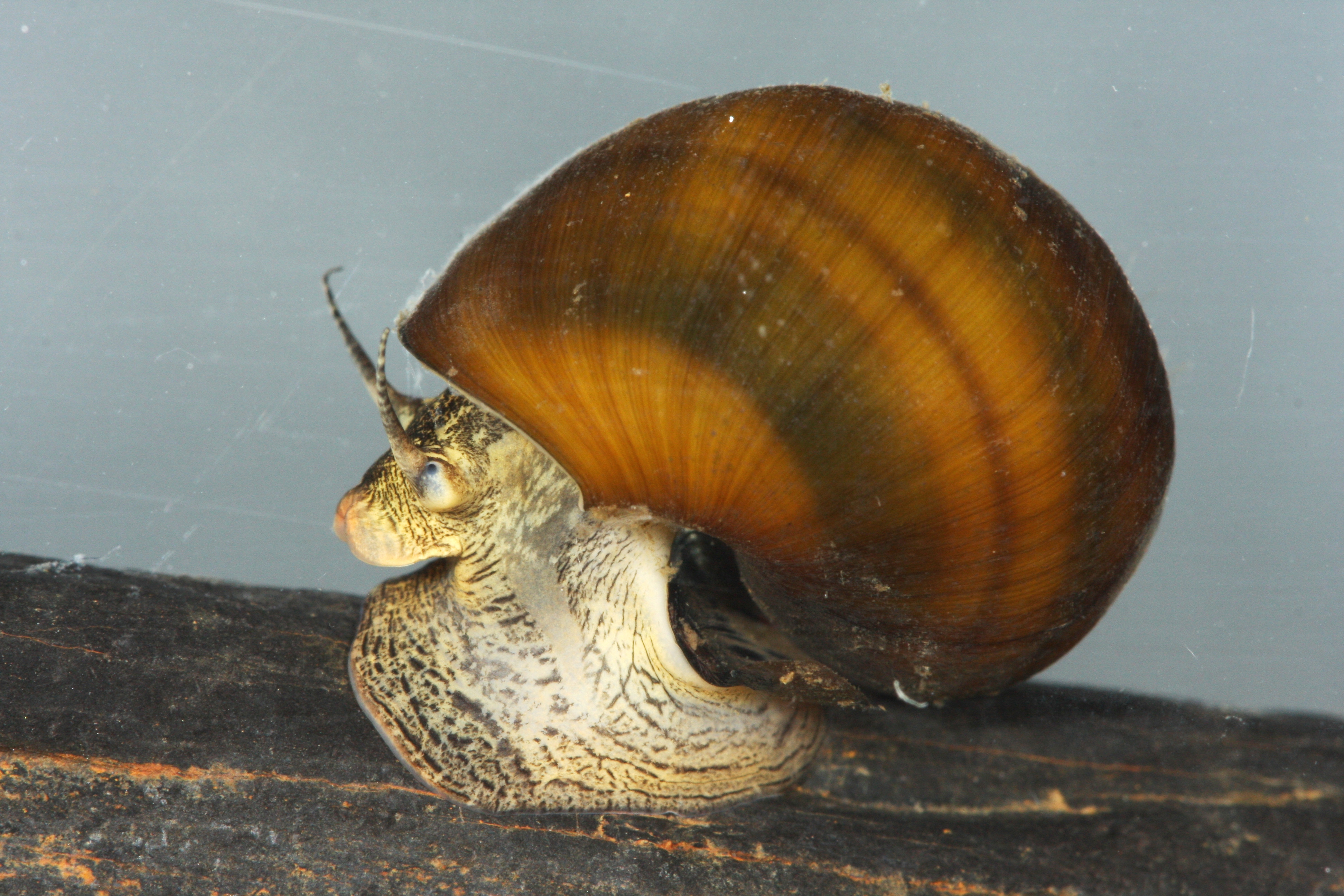
Endangered species
The human impact of the quarry is of first concern to residents of Belle Mina and the SELC, but they aren’t the only ones who will be harmed if their fears about water quality come true.
Three federally endangered species of snails — the armored snail, the Anthony’s river snail and the slender campeloma — and other threatened species call Limestone Creek home.
Johnson, who works with snails, mussels and other freshwater species at the Biodiversity Center, said the Anthony’s river snail was once found in waterways from Knoxville to Muscle Shoals, but now it only has three populations left. The largest of these is in Limestone Creek, near the site where the quarry would discharge wastewater.
“That’s the best population that’s left,” he said, “… so if we lose them there, then we’ve lost a big potential for species recovery.”
The armored snail is found in only two watersheds, and the slender campeloma has been found in four streams, all in northern Alabama.
The snails living upstream of the discharge site would be less affected, Johnson said, but those downstream are vulnerable to changes in pollution or water level in the creek.
Wheeler National Wildlife Refuge, which is about 2.5 miles downstream and is home to 12 endangered species, also expressed concerns to ADEM that this site could harm water quality within the refuge, particularly during storms.
When the Mazda Toyota plant was under construction near Belle Mina, Johnson said the company had a “good partnership” with the U.S. Fish and Wildlife Service to avoid harming the habitat of another endangered species, the spring pygmy sunfish.
“This is a little bit more concerning,” Johnson said of the proposed quarry, “because of the number of discharges and the sheer size of the pit quarry they’re talking about.”
TAKING ADVANTAGE
As they consider all the problems this quarry could cause, some families who live near the proposed quarry site don’t feel like the location choice was an accident.
“The community is upset because they think people are kind of taking advantage of a lower-income community of color,” Bertrand said.
Bertrand said the SELC estimates around 63% of residents within half a mile of the quarry are racial minorities, based on U.S. Census data.
“We’ll keep sending letters, and we’ll just keep showing up until something is done.”
Meagan Alexander, Belle Mina community member
As part of the permitting process, ADEM uses a federal tool called EJScreen, which maps environmental and demographic characteristics of communities that might make them especially vulnerable to environmental justice issues.
The screening showed that only 36% of residents within a mile of the proposed quarry site were people of color and 8% were low-income, meaning that Belle Mina isn’t considered to be an area that is “disadvantaged” or of particular environmental justice concern.
The SELC and EJScreen data for the area are quite different, due in part to their half-mile and 1-mile areas, respectively. Bertrand said he doesn’t believe the EJScreen is returning accurate results due to the Belle Mina community’s small size.
Regardless of the statistics, the quarry’s placement still feels intentional for people like Alexander.
“I believe that considering the rights of the people, I believe it does violate their rights because I believe they targeted this area because of the demographics,” she said.
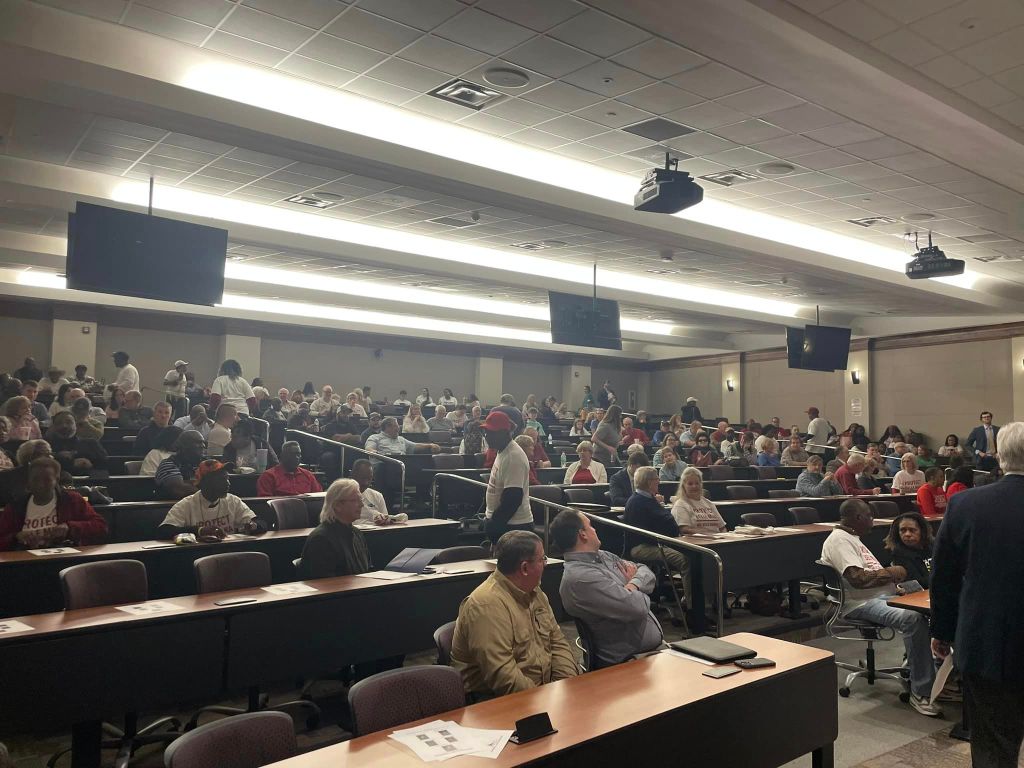
Given the long history of often-toxic industrial sites being placed next to poor and minority communities across the country, Gilliam said it makes sense that the people he talks with are feeling uneasy.
“A lot of us feel like it’s out of our control and that we don’t really have as big of a voice about what’s going in next door to us as we would like. And that’s fair, and I would even say culturally and racially justified,” Gilliam said. “Too often, things like this go in next to African-American communities, and this is one of those times when we would like to say, ‘No,’ and have this stop here.”
Bertrand said there are plenty of spots to quarry limestone, even in the same county, that wouldn’t be as close to a community and wouldn’t be as big of a concern.
“I hope that ADEM does the right thing, I hope that the business does the right thing, and I hope they instead mine limestone in all these other areas that are appropriate,” he said. “… No one would do this to their parents, their brothers, to anyone they love, their friends.”
LAWSUITS AND LEGISLATION
ADEM’s public comment period was supposed to end in late March. However, a lawsuit by Mitchell-Frazier Farms over ADEM’s public notice and comment process resulted in Limestone County Circuit Court Judge Matthew Huggins issuing an order to keep the comment period open while the lawsuit is dealt with.
ADEM spokesperson Lynn Battle said the agency is still compiling its response to the comments it received, but more details won’t be available until the litigation is resolved. She said ADEM couldn’t speculate on when that might occur.
In the meantime, opponents are working every angle they can find to prevent the quarry’s approval.
Gilliam said residents who oppose the quarry have continued to submit comments, with help from the SELC and the nonprofit Research Triangle Institute to address the legal and technical concerns that ADEM considers with permit applications.
ADEM representatives said during the public hearing that the permitting process can’t consider factors like zoning, noise, traffic, property value and other issues that are top concerns for the Belle Mina community. They can only look at the discharge of air and water pollutants from the site, and whether those comply with state and federal law.
“ADEM’s authority regarding quarrying operations and other mining operations is limited,” Hunt said during the hearing. “The department does not have the authority to regulate other aspects of the mining activity, including blasting. Blasting is regulated by the state fire marshal.”
“No one would do this to their parents, their brothers, to anyone they love, their friends.”
Chris Bertrand, Southern Environmental Law Center
An attorney working on behalf of Mitchell-Frazier Farms also requested an inspection by the U.S. Army Corps of Engineers to determine if the quarry property meets the criteria for wetlands that fall under federal protection.
In February, the Limestone County Commission reached out to state Attorney General Steve Marshall to get an opinion about the legality of the quarry’s chosen location. Since 2009, Limestone County has had a law that no quarry may be established in a community within one mile of a TVA Megasite, a property of at least 1,000 acres that is intended for major industry, such as the Powell Road megasite near Belle Mina.
The megasite was certified in 2016, and the Toyota Mazda plant is built on the property. However, since the property is no longer actively certified as a megasite, it’s unclear if this quarry would be in violation of that county rule.
As of mid-April, the county’s attorney, Andrew Dill, said the commission hasn’t received a response. It could come in a matter of days or a matter of months, he said. In the meantime, the commission is waiting to take any action.
Gilliam said he had hopes that a bill introduced into the state Legislature, which would prevent blasting within two miles of a historic site, would be a means to stop the Belle Mina quarry. However, the House’s Limestone County Standing Committee killed the bill in early April.
Gilliam said community members were also planning a protest on May 10 at the bank that holds the mortgage for the quarry property.
“We’ll keep sending letters, and we’ll just keep showing up until something is done,” Alexander said.
If the quarry does get approved, Gilliam said Belle Mina isn’t done fighting.
“We won’t be giving up,” he said.
The community plans to invest in a seismograph, air quality testing equipment and cameras so they can document any damage caused by the quarry, whether it be air pollution, foundation damage or flooding.
“We would rather test it [air quality] while quarry operations are full and running, and to be able to prove to others that they’re harming us,” Gilliam said.
Main article image by Chris Pruitt, courtesy of Wikimedia Commons.

